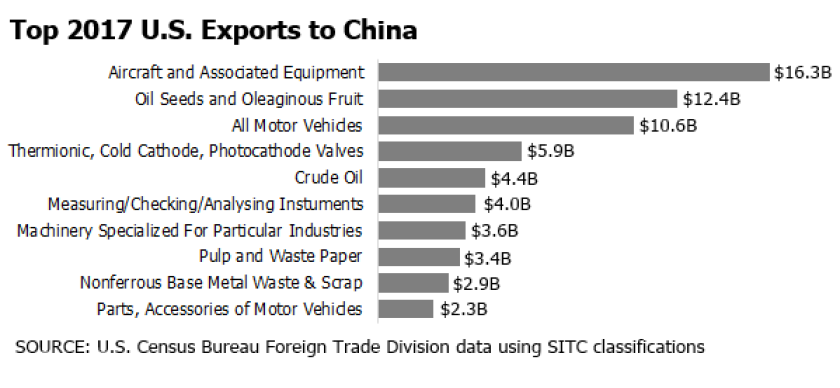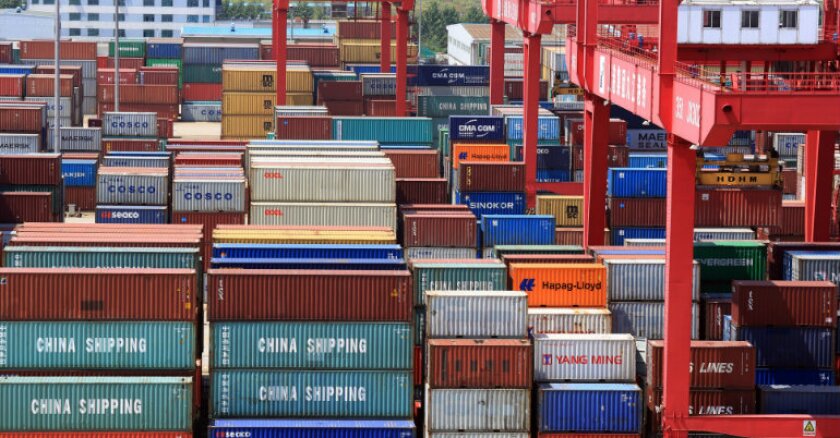Fears of a trade war continue to escalate this week as Chinese officials and the Trump administration threaten to slap tariffs on a growing number of imports, potentially roiling the world’s two biggest economies.
China’s latest announcement, on Wednesday, outlined another round of tariffs on imports from the U.S., bringing the total to more than 230 different products. The initial list of proposed tariffs, which focused on agricultural items, has since been lengthened to include motor vehicles, medical equipment, plastics and a slew of other goods from almost every corner of the U.S. economy.
And on Thursday, President Trump doubled down, calling for $100 billion more in tariffs on Chinese imports.
It’s unknown how the trade dispute will unfold. But what is certain is that the consequences of China's tariffs would play out unevenly across state and regional economies. Although there’s no precise state-level data tracking trade exports, several federal datasets provide an idea of just how much tariffs could disrupt state economies.
Last year, U.S. exports to China totaled $130 billion, an amount that’s grown in recent years. Our calculations of federal trade data suggest that products related to aerospace, soybeans, motor vehicles, electronics and paper alone accounted for nearly half the value of all U.S. exports to China.

Most of these top exports would be affected to varying degrees by the proposed tariffs.
The inclusion of aircrafts on China's list, for instance, could carry significant long-term consequences in regions where jobs in the industry are concentrated, such as Washington state, where Boeing operates several major facilities. The company recently projected greater demand from China, estimating that airlines based in the country would soon account for 20 percent of global demand for new airplanes.
Washington’s aerospace and defense exports to all countries total nearly $52 billion annually, easily the most of any state, according to data reported by the Aerospace Industries Association. Other states with high aerospace and defense export totals include California ($12.6 billion) and Kentucky ($8.8 billion).
China's tariff threat for most types of motor vehicles would further deal a potential blow to the auto industry. Recent figures from the Labor Department’s Quarterly Census of Employment and Wages indicate that auto companies and parts makers support about 180,000 jobs in Michigan. The industry also represents a disproportionately large segment of the workforce in Indiana, Kentucky, Ohio and Tennessee.
The broad industry classification of transportation equipment -- including motor vehicles, aerospace, ships and rail manufacturing -- was responsible for about $29.5 billion of U.S. exports to China last year. Federal data suggests the biggest exporter of transportation goods to the country was Washington state, followed by South Carolina, California, Alabama and Kentucky.
Not all types of transportation equipment would be subject to tariffs under China’s current proposal. Source: Foreign Trade Division, U.S. Census Bureau, 2017 data for NAICS 336
It’s important to note that numbers for some states are inflated because of limitations in how exports are tracked. Products might be shipped from distribution centers in other states, for instance, or consolidated near shipping ports, which wouldn’t reflect where they were actually manufactured. As a result, Washington, South Carolina and other states with major ports report higher totals.
An all-out trade war would stifle port cities at a time when forecasts are calling for strong growth in cargo shipments between the U.S. and Asia. Consider the Port of Long Beach in California, where China accounts for about two-thirds of its imports and a third of all exports.
In the agricultural sector, China ratcheted up pressure on the U.S. significantly with the recent addition of black and yellow soybeans to its tariffs list. The U.S. sent China $12.4 billion in soybeans last year, accounting for over half of the $19.6 billion total for all agricultural exports, according to federal data. A tariff on soybeans could spell trouble for farmers in several mostly Midwestern states, led by Illinois and Iowa. The following map shows 2016 estimates of soybean exports to all countries:
Source: USDA Economic Research Service estimates for total 2016 exports
While China’s proposal would hit most U.S. exports with a 15 percent tariff, it calls for a much steeper additional tariff of 25 percent on pork products. Pork exports support 110,000 jobs nationally, according to the National Pork Producers Council. Iowa is the nation’s largest exporter of pork products, along with Minnesota and North Carolina.
Additional agricultural commodities accounting for sizable, albeit smaller, exports to China include various cotton products, corn, tobacco, and some fruits and nuts. Other top exports, such as fish and dairy products, were excluded from China’s current list of proposed tariffs.
| Agricultural and Related Product | 2017 U.S. Exports to China | China's Proposed Tariffs |
|---|---|---|
| Soybeans | $12,355,952,000 | Tariff proposed |
| Fish Products | $1,233,494,000 | None |
| Cotton | $976,417,000 | Tariff proposed |
| Hides & Skins | $946,225,000 | None |
| Coarse Grains | $836,636,000 | None |
| Dairy Products | $570,263,000 | None |
| Pork & Pork Products | $488,594,000 | Tariff proposed |
| Hay | $377,210,000 | None |
| Wheat | $348,727,000 | None |
| Tree Nuts | $237,697,000 | Tariff proposed |
| Feeds & Fodders | $235,284,000 | None |
| Fresh Fruit | $225,810,000 | Tariff proposed |
| Food Preps. & Misc. Beverages | $193,087,000 | None |
| Meats Not Elsewhere Specified | $186,364,000 | None |
| Tobacco | $162,297,000 | Tariff proposed |
| Corn | $151,883,000 | Tariff proposed |
| Processed Fruit | $143,570,000 | Tariff proposed |
| Planting Seeds | $127,904,000 | None |
| Processed Vegetables | $114,877,000 | None |
| Essential Oils | $113,833,000 | None |
The oil and gas industry, another major segment of the economy, would also likely take a hit. It accounted for nearly $7 billion in exports to China last year. About half of the 143,000 American jobs in the industry are found in Texas, according to Labor Department figures. Other states’ economies relying more on the sector include Colorado, Louisiana and Oklahoma.
Generally speaking, more conservative areas of the country would incur greater consequences if China goes through with its tariffs. The Brookings Institution crunched employment numbers for several industries potentially subject to Chinese tariffs, finding that that they support more jobs in counties won by Donald Trump than Hillary Clinton.
China has not announced an effective date for its tariffs. White House officials said both countries’ plans wouldn’t be implemented for a couple months if they’re unable to negotiate an agreement.








